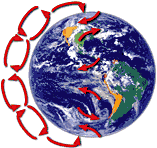Wind Energy Resources: Global Winds
![]()
How
the Coriolis Force Affects Global Winds

The wind rises from the equator and moves north and south in
the higher layers of the atmosphere.
![]() Around 30° latitude in both hemispheres
the Coriolis force prevents the air
from moving much farther. At this latitude there is a high pressure
area, as the air begins sinking down again.
Around 30° latitude in both hemispheres
the Coriolis force prevents the air
from moving much farther. At this latitude there is a high pressure
area, as the air begins sinking down again.
![]() As the wind rises from the equator there
will be a low pressure area close to ground level attracting
winds from the North and South.
As the wind rises from the equator there
will be a low pressure area close to ground level attracting
winds from the North and South.
![]() At the Poles, there will be high pressure
due to the cooling of the air.
At the Poles, there will be high pressure
due to the cooling of the air.
![]() Keeping in mind the bending force of the
Coriolis force, we thus have the following general results for
the prevailing wind direction:
Keeping in mind the bending force of the
Coriolis force, we thus have the following general results for
the prevailing wind direction:
Prevailing
Wind Directions
| Latitude |
90-60°N |
60-30°N |
30-0°N |
0-30°S |
30-60°S |
60-90°S |
| Direction |
NE |
SW |
NE |
SE |
NW |
SE |
The size of the atmosphere is grossly exaggerated in the picture above (which was made on a photograph from the NASA GOES-8 satellite). In reality the atmosphere is only 10 km thick, i.e. 1/1200 of the diameter of the globe. That part of the atmosphere is more accurately known as the troposphere. This is where all of our weather (and the greenhouse effect) occurs.
The prevailing wind directions are important when siting wind turbines, since we obviously want to place them in the areas with least obstacles from the prevailing wind directions. Local geography, however, may influence the general results in the table above, cf. the following pages.
![]()
|
Back | Home
| Forward |
© Copyright 2000 Soren Krohn.
All rights reserved.
Updated 6 August 2000
http://www.windpower.org/tour/wres/globwin.htm